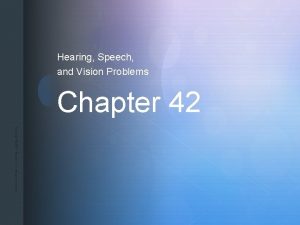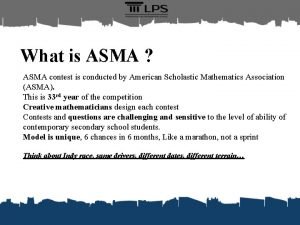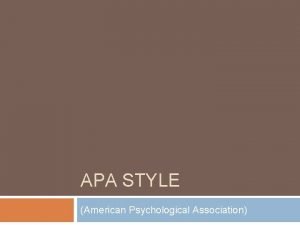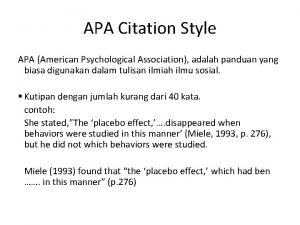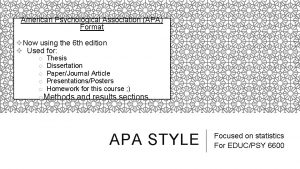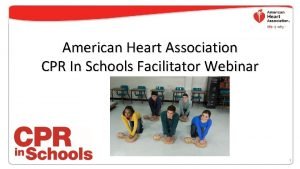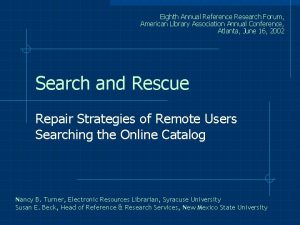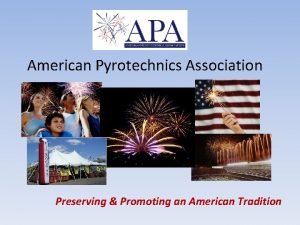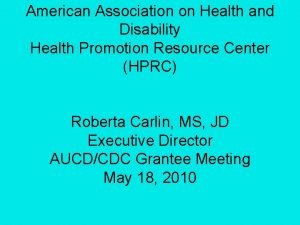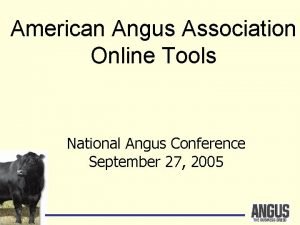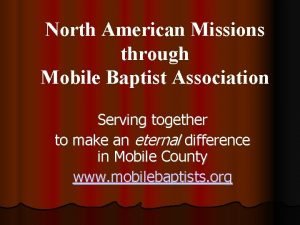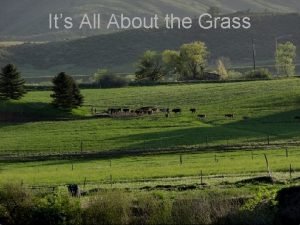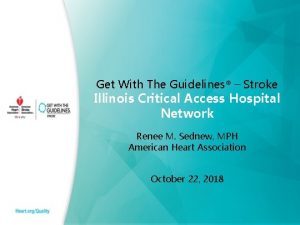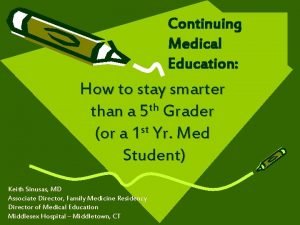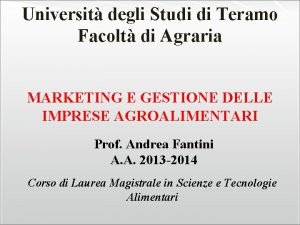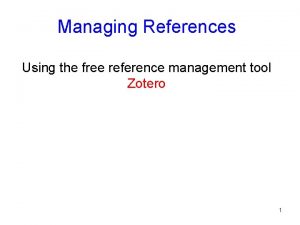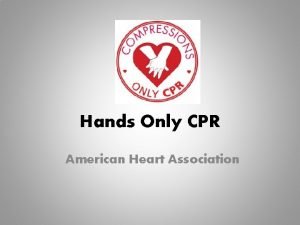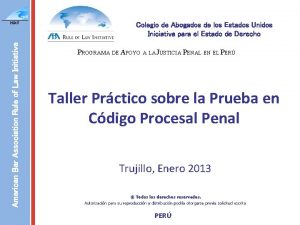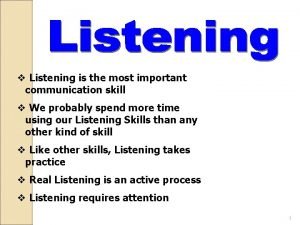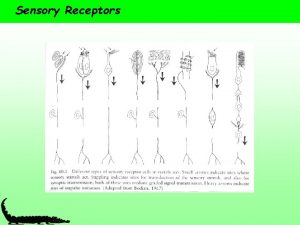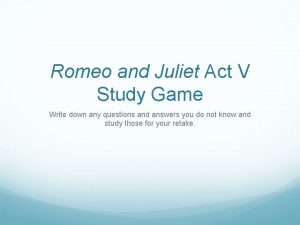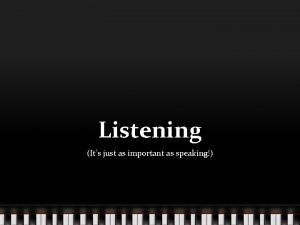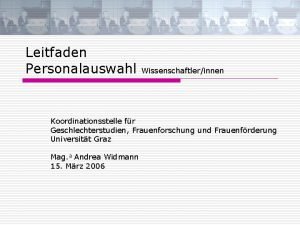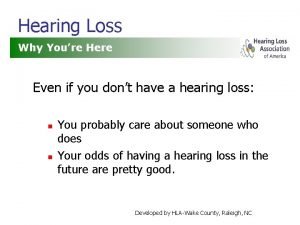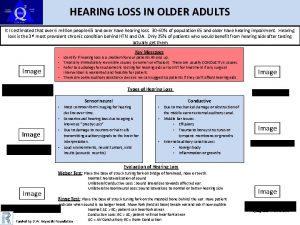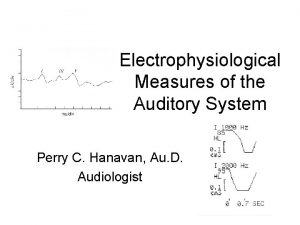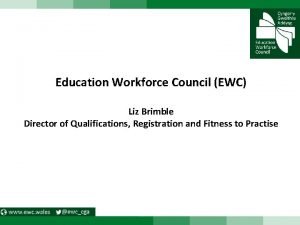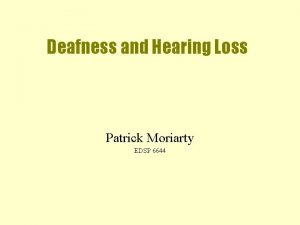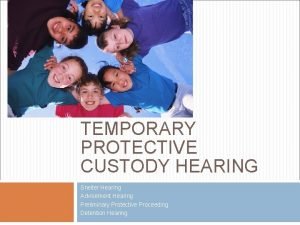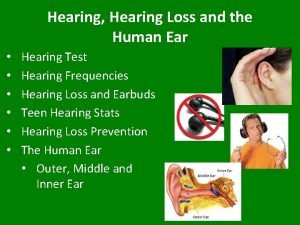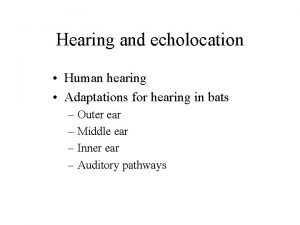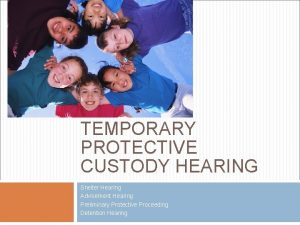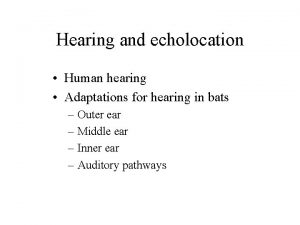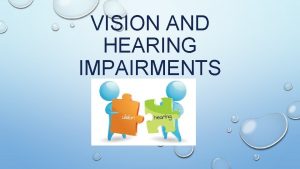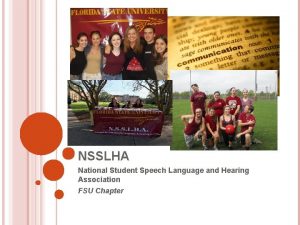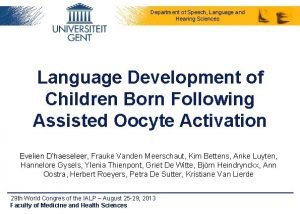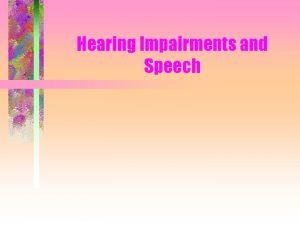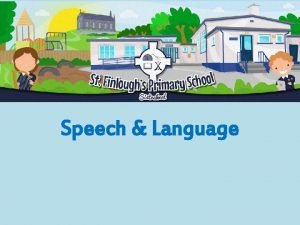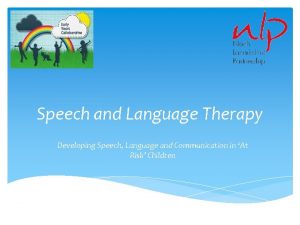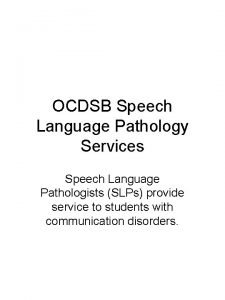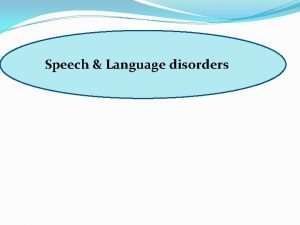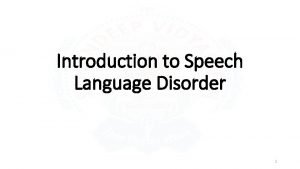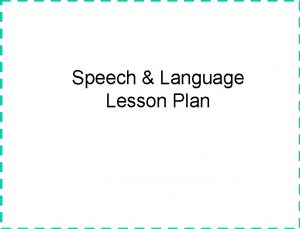Presentation to the American Speech Hearing Language Association












































































































- Slides: 108

Presentation to the American Speech Hearing Language Association November 13, 2003 Preventing Overrepresentation of Culturally/Linguistically Diverse Students Harry N. Seymour & Thomas Roeper University of Massachusetts Amherst, MA Jill & Peter de Villiers Smith College, Northampton, MA Research supported by NIH contract N 01 -DC-8 -2104 *webpage: www. umass. edu/aae

Individuals with Disabilities Education Act (IDEA) • Prior to Education for All Handicapped Children Act (1975) – About half of children with disabilities (2 million) were not receiving a public education • With Individuals with Disabilities Education Act (1997) – About 6 million children with disabilities are now in public education – Graduation rates have increased dramatically – Students who go on to college has almost tripled since 1978.

All is not equal • The benefits of IDEA have not been equitably distributed • Minority children with disabilities, particularly African American, experience: – – less adequate services low-quality curriculum and instruction, and segregation from non-disabled peers. disproportional representation in Special Ed

African American Disproportionality • Over-representation – 14. 8 % of general population – 20. 2% of special education – African American children are the most overrepresented in every special ed category and in nearly every state (Parish, 2002) • Under-representation – Obvious but numbers are unclear

The Educational Dilemma • General education impacts special education • Overrepresentation in special education often mirrors overrepresentation in many undesirable categories--- dropping out, low-track placements, suspensions, and involvement with juvenile justice. • African American children are under-represented in desirable categories---such as gifted and talented. (Office of Civil Rights 1998)

Consequences of Overrepresentation • • Students are mislabeled Students fail to receive services Scarce resources are mis-directed For some, receiving inappropriate services may be more harmful than receiving none at all. • For others, not receiving help early enough may exacerbate learning and behavior problems. • Students are prone to academic failure, behavioral problems, high drop out rate • Segregation from typical peers

Segregation of African American Children in Special Ed. – African American special ed students are far more likely to be educated in separate settings – They experience far less inclusion (Fierros & Conroy, 2002) – 14. 6% graduate compared to 71. 5% of white special ed students

Factors Contributing to Overrepresentation • Lifestyle and health conditions – Higher rates of poverty • African Americans have the highest poverty rate at 22%(US Census) – Higher rates of disease and disability • Diabetes, high blood pressure, cancer, infant mortality, aids • Flawed educational practices

Flawed educational practices • Flawed referral and placement procedures • Flawed testing practices • Systems' inability to cope with children of diverse backgrounds • Flawed instruction in general education programs • Poorly trained teachers

No Single Cause • Poverty alone is an incomplete explanation • Race appears to loom very large as a factor – Large racial disparities in mental retardation compared with learning disabilities – Minimal racial disparities in medically diagnosed disabilities compared with cognitive disabilities – Great disparity from one state to the next – Great disparity between Blacks and Hispanics and between male and female in categories of MR and emotional disturbance

The Language Factor • Often children speak African American English (AAE) • African American English (AAE) is one of many varieties of English, whose status as a dialect is defined by a commonality of speech spoken primarily by African Americans, but not by all. AAE is less geographically defined than other dialects of English , rather it has emerged as a commonality of speech and grammar of a culturally defined group, though there are differences by geographic regions. Of course, children or adults of other races who have strong cultural identification or primary social interaction with African Americans may speak AAE too. Thus, AAE may be defined in terms of the features that distinguish a pattern of grammar (morphology, semantics, syntax and phonology) in the speech used by culturally identified African Americans.

Clinical Implications of AAE • AAE is not a Disorder • Most tests of language are normed for Mainstream American English (MAE) • Content bias – MAE target forms are the standard despite dialect differences • Sampling bias – Too few AAE speakers • The language factor in Spec Ed categories

African American Children in Special Education From p. 6 of Addressing Over-representation of African American Students in Special Education (2002). The Council for Exceptional Children and the National Alliance of Black School Educators, Washington , DC.

National Institutes of Health (NICDD)-Contract 1996 • Development and Validation of a Language Test for Children Speaking Non-Standard English: A Study of Children Who Speak Black English • Contract Award: Spring, 1998 -2004

Research Focus • Avoid somewhat superficial aspects of language – Contrasts between dialects • Focus on deep principles of language every child should know – Noncontrastive elements between dialects – Universal grammar • This is tantamount to making a test harder and more challenging than existing tests

Research Goals • To develop a comprehensive language assessment of syntax, semantics, pragmatics, and phonology between ages 4 and 9. • To be able to determine whether language variation in children is due to Development, Dialect, or Disorder. • To create a test that is not biased against dialect speakers, especially African-American English speakers.

The DELV Tests • DELV-Screening Test – Identifies language variation status – Identifies students at risk for a disorder • DELV-Criterion Referenced Test – Diagnose speech and language disorders • Syntax, Semantics, Pragmatic, Phonology • DELV-Norm-referenced Version – Exclusively on AA children

How well does DELV address the problem? • DELV is a linguistically and culturally fair test • It works as well for African American children as it does for White children. – It distinguishes typically developing students from disordered. – This is achieved despite language variation differences

References • • • Oswald, D. P. , Countinho, M. J. , & Best, A. M. (2002) Community and School predictors of Overrepresentation of Minority Children in Special Education, In Losen, D. J. & Orfield, G. Racial Inequity in Special Education, Harvard Ed Press: Cambridge Office for Civil Rights. U. S. Department of Education Elementary and Secondary School Civil Rights Compliance Reports (2000), available at www. ed. gov/offices/OCR/data. html. Losen, D. J. & Orfield, G. (2002) Racial Inequity in Special Education, Cambridge: Harvard Ed Press. Parish, T. , (2002)Racial Disparities in the Identification, Funding, and Provision of Special Education. In Losen, D. J. & Orfield, G. Racial Inequity in Special Education, Harvard Ed Press: Cambridge Fierros, E. G. , & Conroy, J. W. Double Jeopardy: An Exploration of Restrictiveness and Race in Special Education, In Losen, D. J. & Orfield, G. Racial Inequity in Special Education, Harvard Ed Press: Cambridge

The SYNTAX section of the DELV Theory and Examples Complex WH-questions, Passives, & Articles Tom Roeper, Dept. of Linguistics University of Massachusetts, Amherst

The DELV SYNTAX Domain • • • Focuses on a few core concepts of modern syntax Introduces elements of complexity to reveal hidden knowledge Dialect neutral: draws from universal grammar or structures which have been shown to be constant across dialects

Testing Complex WH-Question Comprehension 1) Can the child answer both parts of a double-WH? 2) Can the child answer questions whose site of origin is far away (long distance)? and 3) Can the child appropriately block meanings that the grammar doesn’t allow, i. e. when there is a barrier?

Double-WH Questions 2 variables in the same sentence: “Who bought what? ” • Answer must refer to all the “whos” and all the “whats” in a paired relationship: • Person 1 bought Thing 1 • Person 2 bought Thing 2 – etc.

This girl played different things in different ways. She played the drums with her feet and the piano with her hands. How did the girl play what? Copyrighted picture omitted c. The Psychological Corporation

Typical Answers to double WH questions • PAIRED, EXHAUSTIVE responses – Ex. She played the piano with her hands and the drums with her feet. • SINGLETONS (Incorrect) – One element: “piano” “with her feet” – Both objects, no instruments: “piano and drums” – One pair: “the piano with her hands. ” • OTHER – “She played a lot. ” “She was playing. ”

Double-WH Example Responses from field testing CHILD A (12663) CHILD B (18221) Feet and her hands She played the piano with her hands and the drums with her feet. Instruments only Paired and exhaustive 0 points 1 point

Double-WH Responses by Age and Language Status

Double-WH Responses by Age and Dialect

Item Type 2 (Long Distance Movement) This mother snuck out one night when her little girl was asleep and bought a surprise birthday cake. The next day the little girl saw the bag from the store and asked, “What did you buy? ” The mom wanted to keep the surprise until later so she said, “ Just some paper towels. ” -- What did the mom say she bought (-)? • Copyrighted picture omitted c. The Psychological Corporation

Typical Answers to “False Clause” questions • LONG DISTANCE (LD) TWO CLAUSE responses – Ex. She said she bought paper towels. • ONE CLAUSE responses (Incorrect) – Ex. (She bought) a birthday cake. • OTHER – “a surprise” “a bag” “I don’t know. ”

WH-False Clause Example Responses from field testing CHILD A (12663) CHILD B (18221) A cake Paper towels 1 clause answer 0 points 2 -clause answer (long distance) 1 point

LD False Clause Response Types by Age and Language Status

Item Type 3 (Barriers to Movement) This mom didn’t know how to bake a cake. She saw a TV program about cooking, and she learned to make a lovely cake with pudding mix. -- How did the mom learn what to bake? • Copyrighted picture omitted c. The Psychological Corporation

Typical Answers to. WH-barriers questions • SHORT DISTANCE responses – (How did she learn…? ) By watching TV. . • MEDIAL ANSWERS (Incorrect) – (…what to bake? ) “a cake” • LONG DISTANCE responses (Incorrect) – (How…. . bake? ) “With a pudding mix, ” “With a spoon” • OTHER – Ex. “She didn’t know how. ”

WH-barrier Example Responses How did she learn what to bake? CHILD A (12663) CHILD B (18221) A cake The TV teached her. Medial Short Distance 0 points 1 point

WH Barrier Response Types by Age and Language Status and Dialect

Other WH Example Responses CHILD A (12663) 2 correct barriers, 2 barrier violations 1 other CHILD B (18221) 4 correct barriers 1 medial 2 points (of 5) 4 points (of 5) Total: 4 of 14 Total: 12 of 14

Who are these children? CHILD A (12663) 5 years old White Female From South Parents w/ HS education Mainstream English speaker Not receiving speech or language services CHILD B (18221) 4 years old African American boy From “north Central” US Parents w/ HS education “Some difference” from MAE” Not receiving speech or language services

Test 2: PASSIVES 3 Question Types Simple passives Testing movement Complex passives Testing for hidden properties (agents, time information) “By-phrases” Focus on “ed” versus “ing”

Simple PASSIVES Does the child distinguish these two sentences? Ex. Someone pushed the elephant. The elephant was pushed. Must choose PASSIVE over ACTIVE or NEUTRAL foil. Simple passives give baseline for child, but are LESS DISCRIMINATING than Complex Passives.

COMPLEX Passives Does the child distinguish these two sentences? Ex. The boy’s face was painted. The boy’s face was being painted. Must distinguish BETWEEN TWO PASSIVES.

Complex Passive Example “The boy’s face was being painted. ” • Copyrighted picture omitted © 2000 The Psychological Corporation.

BY-PHRASE (non)-Passives Does the child distinguish these two sentences? Ex. The plant was dropp. ED by John. The plant was dropp. ING by John. (The plant was dropping right by John. ) Must REJECT the passive when ED does not accompany the “be” auxiliary. Only for passive is the by-phrase licensed by the verb and not an adverb, (or adjunct).

Non-passive “ing” example “The plant was dropping by the boy. ” • Copyrighted picture omitted © 2000 The Psychological Corporation.

Passive Overall Dialect Neutral & Discriminating

Sample children’s responses • • CHILD A (12663) Simple passives 2 of 4 Complex: 1 of 4 Locative by-phrases – 1 of 2 (doesn’t show mastery) • 4 of 10 (chose 5 active foils) • • CHILD B (18221) Simple passives 3 of 4 Complex: 2 of 4 Locative by-phrases – 2 of 2 (lowest 30% of 5 -year-olds) • 7 of 10 (top 70% of 4’s)

ARTICLES on the DELV: Subtle demands on child’s syntax and semantics • Articles differ cross-linguistically, need careful exposure Cf. Spanish use “the hat” for specific and non-specific; Chinese “hat” is specific and non-specific; – English is a MIXED system -- “the hat” is specific and known; “a hat” non-specific • Essentially the same in AAE and MAE – Engages context, presupposition and general knowledge

Making DISCOURSE CONNECTIONS • Need to test WITHOUT PICTURE STIMULI • Which can change conditions on presuppositions, known and new Example of Article Prompt: A bird and a cat were sitting up in a tree. They were friends. One flew away. Which one? THE bird (not A bird) Has the child learned to interpret articles as reference to context from a previous sentence? Is the child sensitive to that relationship?

Use of Articles “a” and “the” Types of a and the in the DELV Condition Label. Description • Part-the: part of a previously mentioned object • Familiar-the: previously mentioned object • Specific-a: referent known to speaker only • Non-referential-a: non-referential, but assumed in situation • Predicational-a: nominal following have

Types of Article Errors • Using “a” for “the” (8 times more common than “the” for “a”) • Bare Singular (“fly kite”) • Irrelevant responses (“My sister has one. ” “The man in the moon. ”) • (when children say “my doll” or “some games, ” they are re -prompted with “anything else? ”)

Development of correct article use in typically developing and language impaired children

Development of correct article use in MAE and AAE speaking children.

After the dialect-neutral diagnosis, then …. . Intervention We are researching interconnections between different areas tested on the DELV, and expect that interventions in one area may have effects in related areas. Ex. Double-wh (set properties, but not barriers) appears to be related to knowledge of “Every” (in Quantifiers). Use of bare singulars in Articles may also be related.

Intervention Concepts • Every construction has a micro-structure • We do not know the crucial triggers • Therefore, try to expose children to all the separate parts, especially: – Three dimensions: • Lexical • Contextual • Conversational

Intervention suggestions (wh) 1. Why do children fail the wh-question? Hypothesis: They do not understand that wh-words list. Goal: Enlist lexical, contextual, and conversational support call for a that reinforces the recognition of multiple subjects in wh contexts:

Lexical Support: (wh example) 1. Ask questions with verbs that imply multiple subjects: Who was SHARING the pie? (more than one person) Who was KISSING? 2. Emphasize multiple subjects with adverb like TOGETHER: 3. Who was talking together? (on test, child and father): Who was eating together? (birthday cake question): Who was talking together? 4. 5.

Contextual Support (wh) Use situation where “singleton” answer is impossible: What is holding up the table? Can’t be just one leg. “What” must refer to all the legs.

Conversational Support: (wh) • If singleton answer is given, add “who else? ” • (father and baby eating): – if child says, “baby was eating” – add “who else? ” (child must silently add “who ELSE…ate something? ”

Conclusions • We have shown that the assessment of complex aspects of children’s syntactic development between the ages of 4 and 9 can be carried out in a dialect neutral fashion. • These materials and procedures capture the development of several aspects of language that are vital for success in early schooling and the transition to literacy. • They provide the clinician with a substantial profile of the child language strengths and weaknesses, not just a diagnostic categorization. • As such they provide a much richer evaluation of language variation and its sources that has direct implications for areas and methods of intervention.

Learning words Why do standard tests fall short? • Vocabulary is learned in a cultural context. • Families vary in what they talk about to children. • Children may not all have the same opportunities to learn a rich vocabulary. • Children may not all have the same opportunities to learn the words that get onto tests. • Picture-based tests tend to be biased to what can be “pictured”! • As a result, nouns are sampled more than verbs. • Semantics is about more than learning names!

A new approach to assessment? • Bias of acquired vocabulary tests: too culturally dependent? • Want to look at process: CAN the child learn a new word easily? • This should be a predictor of whether the child can learn vocabulary in the school context.

Syntactic Bootstrapping and Fast Mapping of Word Meanings from Context • Children acquire a verb’s meaning in part through the argument frames in which it appears. This phenomenon of fast mapping of meanings from context is often called syntactic bootstrapping. • We test how much children can learn from intransitives, datives, and complement argument frames. • Nonsense verbs were used in these frames to describe strange actions in ambiguous contexts. The child then answered questions about the verb and its subjects and/or objects.

Argument structures • Intransitive: one argument E. g. the dog is barking • Transitive: two arguments E. g. The boy poured the drink • Dative: three arguments E. g. The mailman handed the letter to the boy • Complement: three arguments E. g. The policeman asked the woman to stop the car

The girl is zanning the apple to the clown. Which one was the zanner? Which one got zanned? • Copyrighted picture omitted ©The Psychological Corporation

The girl is sugging the man to send the ball. Which one sugged the man? Which one did the girl sug to send the ball? ©The Psychological Corporation

Question types • • ING e. g Which one is zanning? (agent) ER e. g. Which one is the zanner? (agent) Got-ED e. g. Which one got zanned? (patient) ABLE e. g. Which one is zannable? (patient) Subj-comp e. g. Which one did she sug (e) to send the ball? Obj-comp e. g. Which one did she sug the man to send (e)?

Development of fast mapping skills across all syntactic contexts in MAE and AAE speaking children.

Development of fast mapping skills across all syntactic contexts in typically developing versus language impaired children.

AAE • African-Americans often speak a distinctive variety called African-American English (AAE). • That variety has phonological, morphological, lexical and syntactic characteristics different from Mainstream American English (MAE).

Some special properties of AAE Characteristic features: • Aspect has priority over tense; unique forms – Harry be workin’ at U. Mass for ever. – Mama done set the table • Negative concord – She don’t have no shoes – Ain’t nobody mess with no meter maid. (Green, 2001).

AAE morphosyntax and phonology is different from MAE • Tense/agreement is often not marked: – Last week she flip out. – My father walk to work. • Copula is limited to contexts where it carries meaning: – She real nice. – I was tired after that. • Phonology: consonant cluster reduction in final position only: – Las’ week she had to take a tes’. – Yesterday he straightened it out.

The problem • The tests designed to establish whether a child has a language disability or delay take Mainstream American English as the norm. • The tests are standardized on a sample that matches census data, with typically 10% or fewer of African-American children. • This is claimed to be a representative sample for judging African-American children.

Even worse problem For efficiency the tests choose those parts of Mainstream English most easily “measured”: • A) Acquired Vocabulary • B) Morphemes supplied in their obligatory contexts, such as plural, past, possessive, 3 rd person, copula and auxiliary be. But A) is subject to cultural as well as linguistic variation, and And B) happens to pick out those linguistic features of MAE most likely to be absent in AAE speech.

Our solution, for now • The DELV test has a screener version that takes 15 to 20 minutes to do. • The screener contains morphosyntax and phonology Identifier Items on which AAE-speaking children produce systematically different responses from MAE. This is not part of the diagnostic scoring. • It also contains a set of Diagnostic Items designed to tell the clinician whether further testing is needed because the child is at risk for language delay or impairment. These are dialect-neutral.

Screener Identifier Items Morphosyntax • Have/has • 3 rd person present tense ‘s • Doesn’t/don’t • Be copula forms Phonology • Distinctive AAE phonology (e. g. , “baf” for “bath”, “gif” for “gift”)

Performance of the different dialect and impairment status groups on the Identifier Items on the DELVSC (Non-mainstream responses).

Screener Diagnostic Items • Past tense was/were auxiliary and copula forms (obligatory in both MAE and AAE). • Elliptical Possessive pronouns (e. g. hers, theirs: obligatory in both MAE and AAE). • Non-word Repetition • Wh-Question Comprehension

Performance of typically developing and language impaired children on the Diagnostic Items on the DELV-SCR (Errors)

Performance of MAE and AAE speaking children on the Diagnostic Items on the DELV-SCR (Errors)

How does this help? • By avoiding areas that are different across dialects, we attempt to reduce the problem of false representation of children who speak dialects such as AAE. • It is only a useful strategy if we still find some children who fail our tasks, i. e. if genuine language disorders have broader effects than on these elements of morpho-syntax. • Fortunately, we find rich evidence that they do!

Pragmatics Domain What did we test? • All the pragmatics subtests assess the interaction of syntactic and semantic forms with specific pragmatic functions -- assessment of pragmatic skills cannot be divorced from the forms that are needed for those functions of language (Bloom & Lahey, 1978). • They assess pragmatic skills that are important for early school success and literacy development (e. g. , question asking, narrative cohesion, taking another speaker’s point of view, theory of mind). • They test language skills where there are no documented pragmatic differences between MAE and AAE.

Pragmatics Domain What did we not test? • Interactive conversational skills such as turn taking, topic initiation, etc. are best assessed in naturalistic conversation or language sampling rather than in a more formal picturebased test. • Language style or speech register adjustments for reasons of status, formality, or age vary with cultural conventions and probably vary with cultural groups that speak different dialects of English. • In the area of narrative we focused on linguistic cohesion rather than more global story structure (e. g. , story grammar features), since there is evidence that young AAE-speaking children may produce a wider range of story structures in open-ended narration (e. g. , Michaels, 1981; Champion, 2003)

Pragmatics Domain Key Features of all the Elicitation Materials and Procedures • They provide specific referential support and pragmatic motivation for the target language forms and content to be produced by the child, so they increase the likelihood that those forms and functions will be sampled. • The pictured materials and elicitation prompts constrain the range of appropriate utterances, so they are more easily and quickly coded than an open-ended language sample. • The procedures retain a considerable degree of natural communication rather than resorting to direct imitation. • All of the procedures are picture-based so they require minimal technology and can be administered and scored “on-line” by a single clinician interacting with the child.

Wh-Question Asking • The child is shown a picture with something missing from it and have to ask the right question to find out what the event is about. • The missing elements of the pictures include objects, people, locations, tools, and causes of emotions -- so what, who, where, how, and why questions are motivated. • Different levels of prompting are given for each trial if the child does not spontaneously ask an appropriate question -varying from the semantic domain of the question to ask, to the specific wh-word to begin the question with. • If the child asks an appropriate question they are shown the complete picture. • The children’s productions are scored correct on the basis of semantic and pragmatic appropriateness, not morphosyntax features that may vary with dialect.

The girl is painting something. Ask me the right question and I’ll show you the answer. c. The Psychological Corporation

What? c. The Psychological Corporation

The nurse is feeding somebody. Ask me the right question and I’ll show you the answer. • Copyrighted picture omitted c. The Psychological Corporation

Who? • Copyrighted picture omitted c. The Psychological Corporation

The girl is mad for a reason. Ask me the right question and I’ll show you the answer. • Copyrighted picture omitted c. The Psychological Corporation

Why? • Copyrighted picture omitted c. The Psychological Corporation


Wh-Question production in MAE and AAE speaking children following all prompts.

Wh-Question production in typically developing and language impaired children following all prompts.

Wh-Question Error Patterns -Developmentally Ordered • Failure to ask a question, just guessing. To • Asking the wrong Wh-question for the information needed or asking an all-purpose question such as “what is happening? ” To • Fine on the single Wh, but unable to produce a double Wh such as “who is eating which food? ”

Short Narratives have three important components: • Coherence = use of required story plot structure components • Cohesion = a. use of linguistic devices to establish, maintain, and specify referents (e. g. , articles and pronouns, or referent characterizing expressions) b. expression of causal and temporal links between events in the story. • Adopting different perspectives on the events -- “inside” versus “outside” view -- “landscape of action” versus “landscape of consciousness” (Bruner, 1986). This depends on having a “theory of mind”.

A short, wordless picture-sequence narrative to elicit reference specification, temporal cohesion, and mental state references. • Copyrighted picture omitted c. The Psychological Corporation

Narrative Samples 1 • I want my train. I’m gonna hide the train from him. I’m gonna play out of the toy box. I’m gonna find that train. Bring that train. (C: 4; 2) • He was looking for the choo train because the other boy was playin’. And then… and then he said, “I want that choo train back”, and umm… he put it in his toy box. And then he came back to find it and he looked under the bed and it wasn’t there. (SC: 4; 9)

Narrative Examples 2 • The big boy came into the little boy’s room and took away the little boy’s train. Then he hid it under the boy’s bed where he couldn’t get it. Then the little boy… when he left… he got out his train and put it in the toy box while the big boy was eating. Then the big boy thought about the train and he went under the bed to go see it but it wasn’t there. (A: 6; 4) • The little brother was trying to get his toy from the big brother. And the big brother hiding his toy under the bed. When he is eating his sandwich, the little boy go and get it and put it inside of his toy box. When his big brother walk in, he think about the train and he look under his bed for it. (J: 6; 3)

Following their spontaneous narrative the children were asked two followup questions to probe for their theory of mind understanding: -- Tell me again what is happening in this picture (picture 5) --The big boy is looking for the train under the bed. Why is he looking there? • Copyrighted picture omitted c. The Psychological Corporation

Four-year-old AAE Children

Six-year-old AAE Children

Narrative Features Reference Contrast and Time Developmental Patterns • No contrasting reference to the characters To Use of adjectives (“big”, “little”) and specific nouns (“boy” vs “his brother”) • No temporal links between events or “and” To Only sequencers (“then”) To Adverbial clauses of time (“when”, “after”)

Narrative Features Mental State References Developmental Patterns Picture 5 Description • No reference to mental states To Reference to intention or desire To Reference to cognitions (“think”, “remember”, “dream”) Explanation of why character looks under the bed: • No explanation To • Intention or desire (“to get…”, “wants…”) To • False belief explanation

Development of combined narrative skills in MAE and AAE speaking children aged 4 to 12.

Overall narrative scores in typically developing and language impaired children aged 4 though 12.

Development of MAE and AAE speaking children on the Pragmatics Domain Score

Development of typically developing and language impaired children on the Pragmatics Domain Score

Conclusion • The pragmatics subtests enable an unbiased assessment of important pragmatic skills without relying on linguistic features that vary between AAE and MAE. • They produce strong developmental data between the ages of 4 and 9 with no dialect differences. • But for both the MAE and AAE speaking groups they also strongly discriminate between children who were a priori characterized as typically developing and languageimpaired.
 Canadian hard of hearing association bc
Canadian hard of hearing association bc Chapter 42 hearing speech and vision problems
Chapter 42 hearing speech and vision problems Bsc speech
Bsc speech Asma math competition
Asma math competition Vandelay art. seinfeld the show about nothing. penguin 1997
Vandelay art. seinfeld the show about nothing. penguin 1997 Galvanizing association
Galvanizing association American marketing association definition brand
American marketing association definition brand American heart association recommends child cpr for:
American heart association recommends child cpr for: American berkshire association
American berkshire association American baking association
American baking association How to do an in text citation apa format
How to do an in text citation apa format American psychological association (apa) style adalah
American psychological association (apa) style adalah American psychological association example
American psychological association example American heart association cpr in schools training kit
American heart association cpr in schools training kit American alzheimer's association
American alzheimer's association The miller test
The miller test New york mental health counselors association
New york mental health counselors association North american gaming regulators association
North american gaming regulators association North american association for environmental education
North american association for environmental education American library association
American library association American pyrotechnics association
American pyrotechnics association American psychiatric association annual meeting 2020
American psychiatric association annual meeting 2020 American association on health and disability
American association on health and disability American angus association login
American angus association login American thyroid association guidelines pregnancy 2017
American thyroid association guidelines pregnancy 2017 American gas association
American gas association Mobile baptist association
Mobile baptist association Griffin concierge medical cost
Griffin concierge medical cost Psychiatric nurse conference
Psychiatric nurse conference American association on health and disability
American association on health and disability Cuban american association of civil engineers
Cuban american association of civil engineers American association of caregiving youth
American association of caregiving youth American statistical association salary survey
American statistical association salary survey Donmeg developments
Donmeg developments American heart association 2020
American heart association 2020 Aafp metric
Aafp metric Oak schuetz
Oak schuetz American gelbvieh association
American gelbvieh association Lcm particle analyser
Lcm particle analyser American marketing association
American marketing association American burn association clasificacion de quemaduras
American burn association clasificacion de quemaduras Pemasaran menurut american marketing association
Pemasaran menurut american marketing association Journal of the american medical association
Journal of the american medical association Jnc 8
Jnc 8 Journal of american medical informatics association
Journal of american medical informatics association American heart association
American heart association American psichological association
American psichological association American bar association rule of law initiative
American bar association rule of law initiative The american dream powerpoint
The american dream powerpoint Hát kết hợp bộ gõ cơ thể
Hát kết hợp bộ gõ cơ thể Bổ thể
Bổ thể Tỉ lệ cơ thể trẻ em
Tỉ lệ cơ thể trẻ em Voi kéo gỗ như thế nào
Voi kéo gỗ như thế nào Chụp phim tư thế worms-breton
Chụp phim tư thế worms-breton Chúa sống lại
Chúa sống lại Kể tên các môn thể thao
Kể tên các môn thể thao Thế nào là hệ số cao nhất
Thế nào là hệ số cao nhất Các châu lục và đại dương trên thế giới
Các châu lục và đại dương trên thế giới Công của trọng lực
Công của trọng lực Trời xanh đây là của chúng ta thể thơ
Trời xanh đây là của chúng ta thể thơ Cách giải mật thư tọa độ
Cách giải mật thư tọa độ Làm thế nào để 102-1=99
Làm thế nào để 102-1=99 độ dài liên kết
độ dài liên kết Các châu lục và đại dương trên thế giới
Các châu lục và đại dương trên thế giới Thể thơ truyền thống
Thể thơ truyền thống Quá trình desamine hóa có thể tạo ra
Quá trình desamine hóa có thể tạo ra Một số thể thơ truyền thống
Một số thể thơ truyền thống Cái miệng nó xinh thế chỉ nói điều hay thôi
Cái miệng nó xinh thế chỉ nói điều hay thôi Vẽ hình chiếu vuông góc của vật thể sau
Vẽ hình chiếu vuông góc của vật thể sau Nguyên nhân của sự mỏi cơ sinh 8
Nguyên nhân của sự mỏi cơ sinh 8 đặc điểm cơ thể của người tối cổ
đặc điểm cơ thể của người tối cổ Thế nào là giọng cùng tên?
Thế nào là giọng cùng tên? Vẽ hình chiếu đứng bằng cạnh của vật thể
Vẽ hình chiếu đứng bằng cạnh của vật thể Fecboak
Fecboak Thẻ vin
Thẻ vin đại từ thay thế
đại từ thay thế điện thế nghỉ
điện thế nghỉ Tư thế ngồi viết
Tư thế ngồi viết Diễn thế sinh thái là
Diễn thế sinh thái là Dot
Dot Số.nguyên tố
Số.nguyên tố Tư thế ngồi viết
Tư thế ngồi viết Lời thề hippocrates
Lời thề hippocrates Thiếu nhi thế giới liên hoan
Thiếu nhi thế giới liên hoan ưu thế lai là gì
ưu thế lai là gì Hổ sinh sản vào mùa nào
Hổ sinh sản vào mùa nào Sự nuôi và dạy con của hươu
Sự nuôi và dạy con của hươu Sơ đồ cơ thể người
Sơ đồ cơ thể người Từ ngữ thể hiện lòng nhân hậu
Từ ngữ thể hiện lòng nhân hậu Thế nào là mạng điện lắp đặt kiểu nổi
Thế nào là mạng điện lắp đặt kiểu nổi Insulated listening definition
Insulated listening definition Listening vs hearing
Listening vs hearing We listen
We listen What are the different types of sensory receptors
What are the different types of sensory receptors Romeo and juliet act v study guide
Romeo and juliet act v study guide Hearing on advisement
Hearing on advisement Types of listening
Types of listening Hearing personalauswahl
Hearing personalauswahl Spatial agreement asl
Spatial agreement asl Gangguan pendengaran icd 10
Gangguan pendengaran icd 10 Hoglund brain imaging center
Hoglund brain imaging center Factual distractions
Factual distractions Cookie bite hearing loss
Cookie bite hearing loss Conductive hearing loss lateralization
Conductive hearing loss lateralization Oae results
Oae results Education workforce council
Education workforce council Dha
Dha Hearing impairment meaning
Hearing impairment meaning

